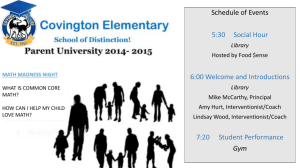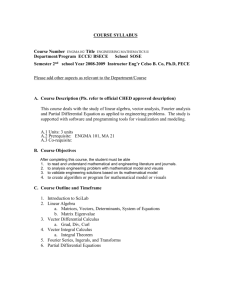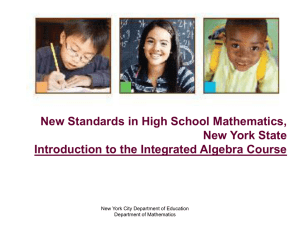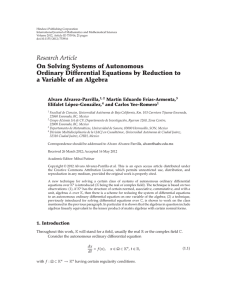Think - Gold Coast Science Network
advertisement
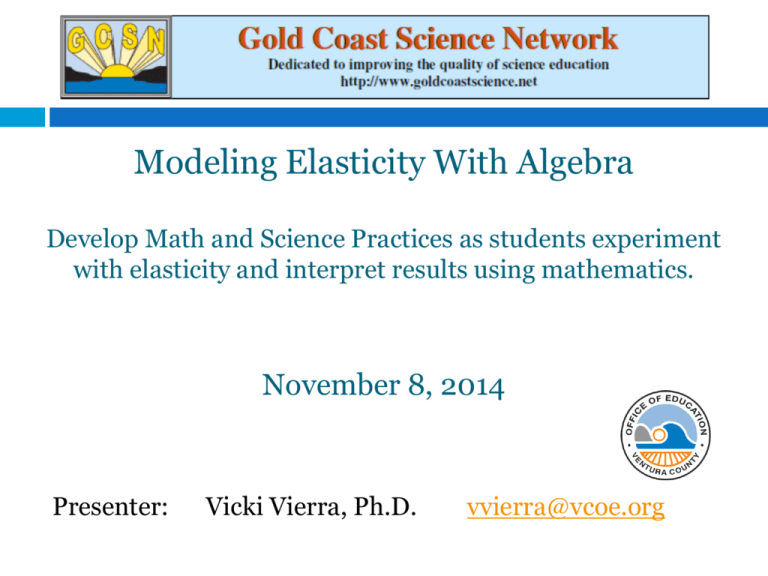
Modeling Elasticity With Algebra Develop Math and Science Practices as students experiment with elasticity and interpret results using mathematics. November 8, 2014 Presenter: Vicki Vierra, Ph.D. vvierra@vcoe.org GOAL: To create students who are college and career ready MEANS: Develop 21st Century skills – the 4 “C”s – Communication, Collaboration, Creativity, and Critical Thinking. Agenda: 3 Welcome & Introductions Standards for Mathematical Practice Scientific and Engineering Practices The Practices in Action - Hooked on Algebra Introductions Please share: Name and site Classes One you teach of your personal numbers 4 Never Tell An Answer Please remember the enormous responsibility we all have as learners not to spoil anybody else’s fun. The quickest way to spoil someone else’s fun is to tell them an answer before they have a chance to discover it themselves. Susan Pirie Think-Pair-Share Think: What are the characteristics of a good problem solver? In science? In math? Does it matter? Pair – talk to a partner Share with the group Part 1: Standards for Mathematical Practice 1. Make sense of problems and persevere in solving them …start by explaining the meaning of a problem and looking for entry points to its solution 2. Reason abstractly and quantitatively …make sense of quantities and their relationships to problem situations 3. Construct viable arguments and critique the reasoning of others …understand and use stated assumptions, definitions, and previously established results in constructing arguments 4. 7 Model with mathematics …can apply the mathematics they know to solve problems arising in everyday life, society, and the workplace Part 2: Standards for Mathematical Practice 5. Use appropriate tools strategically …consider the available tools when solving a mathematical problem 6. Attend to precision …communicate precisely using clear definitions and calculate accurately and efficiently 7. Look for and make use of structure …look closely to discern a pattern or structure 8. Look for and express regularity in repeated reasoning …notice if calculations are repeated, and look for both general methods and for shortcuts 8 8 Scientific & Engineering Practices 1. 2. 3. 4. 5. 6. 7. 8. Asking questions for science & defining problems for engineering Planning & carrying out investigations Analyzing & interpreting data Developing & using models Constructing explanations for science & designing solutions for engineering Evidence-based argumentation Using mathematics & computational thinking Obtaining, evaluating, and communicating information Hooked on Algebra Models for Understanding Linear Functions Elasticity is the ability of a material to spring back to its original shape and size after it has been stretched Robert Hooke called the force acting upon a material the stress, and the elongation it produces the strain Complete the experiment, graph your data, and write about what you notice Based on your work, what is the relationship between the stress and the strain? What Are We Doing? Where in the world does Hooked on Algebra fit? Is it math? Is it science? Are math practices addressed? Are science and engineering practices addressed? Explain your rationale Thank you ! Thanks for all your Communication, Collaboration, Creativity and Critical thinking! Vicki Vierra vvierra@vcoe.org


